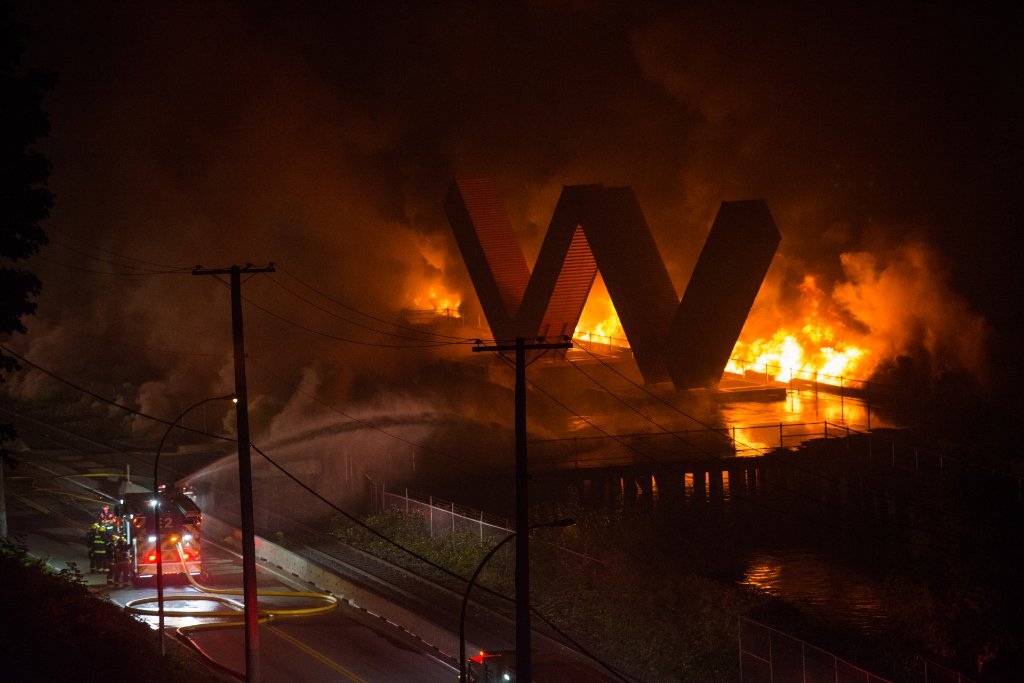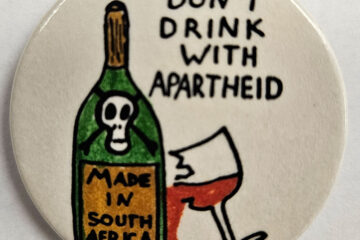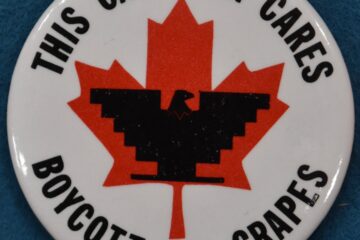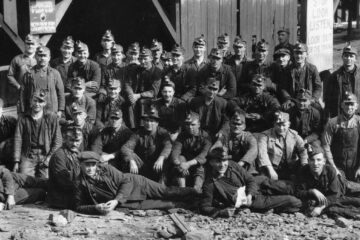A Historic Pier, In Flames
 Written and researched by Bailey Garden
Written and researched by Bailey Garden
(Note: Bailey previously worked with the (Re)Claiming the New Westminster Waterfront research project, content which is referenced in this article)
In a week where the Lower Mainland of British Columbia is blanketed with smoke from unprecedented wildfires along the US West Coast, the ferocious reality of fire erupted on the historic New Westminster pier last night – Sunday, September 13th, 2020.
The fire was still burning at Pier Park this morning, though fully contained to the old pier section. It is expected to last a few days, until it can be extinguished completely. The cause and extent of the fire is still unknown, but Westminster Pier Park appears to be a loss. The iconic “WOW Westminster” public art installation still stands but has likely been compromised and will need to be torn down. The park burned with such fiery intensity due to the creosote-soaked original pilings upon which this stretch of pier sits. The creosote was meant to keep the 100+ year old “timber wharf” from rotting, but in this case, worked as fuel that has produced toxic fumes since ignition. The newer sections of pier, home to the River Market, Fraser River Discovery Centre, Inn at the Quay, and residential condos just 1 KM away from the park, are built on steel pilings which helped to stop the spread.
Westminster Pier Park is an award-winning, 3.84 hectare public space that officially opened in late 2012 with amenities including a boardwalk, festival lawn, concession building, grass and garden areas, two sand volleyball courts, accessible picnic tables, a basketball court, public art, and two preschool aged playgrounds with a spray water park. Pier Park connects people with the Fraser River, giving them an up-close view of a working waterfront, with the active Fraser Surrey docks visible across the water. Much of the public art was inspired directly by the labour history in this area – the metal “Memory Band” that runs the length of the park with the names of significant New West people, places and things, 117 panels in total; the “Community on the River” photo seat wall, showcasing 87 historic photos and 35 children’s photos; and of course, the “WOW Westminster” sculpture by Brazilian artist José Resende, a massive red “W” formed from 4 shipping containers as a visual reminder this was a busy port and industrial waterfront before it was a place of recreation and relaxation.
This is not the first fire to threaten the New West waterfront. Almost 122 years ago to the day, Sept. 10, 1898, the Great Fire of New Westminster broke out at the foot of 4th St – the very same location where a pedestrian overpass connects Pier Park to Columbia Street. Unlike the Pier Park fire of 2020, the Great Fire was not contained to the waterfront and devastated a major portion of New Westminster’s downtown core; but much of the story is familiar, with the fire starting late on a Saturday night and burning well into the next day. In a matter of hours, the market, docks, opera house, library, post office, churches and the city’s Chinatown were gone. The source of the flames was a warehouse at B&K Wharf on Front Street, where several tonnes of hay were being stored; by the time the volunteer Hyack Brigade was alerted at 11 PM, the warehouse was consumed, and the flames were spreading to the City Market. Strong winds pushed the flames further: the CPR Warehouse, Sinclair & Western Fisheries salmon canneries, and even steamers docked at the wharf were ablaze, the flames causing the mooring ropes to break free and send them careening down the Fraser to ignite anything they came into contact with. The fire spread to Columbia Street and soon the entire area from Royal Avenue to the waterfront, save a few buildings, was devastated. Even the No. 1 Fire Hall burned.
Of course, the “Royal City” rebuilt itself from the ashes, but there have been many close calls since then. In a series of oral history interviews conducted by the (Re)Claiming the New Westminster Waterfront research project in 2014, 94-year-old retired marine gas station operator Tom Mark recalled the time he stopped another fire from claiming the waterfront during a strike by the International Woodworkers of America (IWA) in the 1960’s. In another interview, Joanna “Pinky” Zabinsky recalled working at a fruit cannery along the waterfront. These clips and others were used in a self-guided “Memory Walk” of the New Westminster waterfront, a series of podcasts which demonstrate the wide variety of industries that existed on this stretch of water for years.
Stops 5, 6 & 7 of the New West walking route took users through Westminster Pier Park before taking the overpass back to Columbia Street. The adjacent parking lot, the only entrance to the park prior to the pedestrian overpass, stood on what was once the Overseas Transport docks of New West’s working port. Part of what makes the shipping container “W” of WOW Westminster so significant is the ironic symbolism of the sculpture. Many park visitors, especially younger ones, are likely unaware that New Westminster was the first incorporated city of British Columbia and established specifically with industry on the Fraser River in mind, displacing the Indigenous Qayqayt First Nation in the process. As the rest of the province grew, New Westminster found itself overlooked for more favourable locations; the city of Victoria was granted free port status, stifling the growth of New Westminster, and the capital was moved to its present location there in 1866. Though New West secured a Canadian Pacific Railway (CPR) branch in 1886, the completion of the main, transcontinental line to Vancouver in 1887 shifted more work to that city’s port on the Burrard Inlet, which had the added benefit of never freezing over.
The New West port persisted, a major employer in the community for nearly a century until its ultimate downfall came about from the city’s original grid design by the Royal Engineers. Having the railroad tracks in such proximity, running parallel to the docks, made for easier longshoring work when everything was stowed by hand, and the waterfront was filled with canneries, sawmills and more. Goods could be produced and prepared for shipping all within a few kilometres.
However, with the shift to automation and containerization in the shipping industry starting in the 1960’s, the railroad tracks later served as a constrictive boundary which prevented the expansion of the New Westminster port to accommodate. Coupled with competition from neighbouring ports and the closure of most industry along the waterfront, the New Westminster port could not survive. WOW Westminster, standing amongst the burnt timbers the morning after the 2020 fire, reminds us of what came before the park and the workers who were ultimately displaced in favour of residential and recreational spaces. In Stop 5 of the Memory Walk, retired longshoremen Joe Breaks, Don McIntosh and Dean Johnson recalled working on these historic docks, and Denise Block recounted her experience as the first female longshoreman on the New Westminster waterfront.
The “Memory Band” and the “Community on the River: The Place Where People Meet” installations both demonstrate how this labour history is woven into the social and cultural history of the community. Among photos of smiling children watching parades are striking images of mighty fishing fleets; the names of specific worksites, like Heaps Engineering, Westminster Paper Mills and Vulcan Iron Works are celebrated right alongside local dignitaries like Premier Richard McBride.
The damage to this historic pier marks much more than the loss of a well-loved recreational space; it is the loss of a site of remembrance. It is not the first or worst fire along the New Westminster waterfront, but the 2020 Pier Park fire is a tragedy, nonetheless.
(Cover photo by Paul Romein, Sept. 13, 2020 via City of New Westminster on Twitter)


